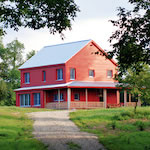DETAILS
Location Holly, MI
Program Single-family residence
Size 2,000 ft2
Completion 2013
Certification International Passive House Standard
Climate Continental
Architect GO Logic
Sheathing Huber ZIP System
The red-and-silver house is posed on the side of a lake, its many windows giving off a soft yellow glow framed by pines and long grass. The home is reminiscent of an antique farmhouse, a fitting addition to the Michigan countryside. The residence does not broadcast its status as Michigan’s first Passive House, or as the recipient of Fine Homebuilding’s 2014 Home of the Year award.
The Jung Haus is far from the first Passive House project undertaken by GO Logic; the Maine-based architecture firm built the LEED-certified Warren Woods Ecology Field Station and Cabins for the University of Chicago, the TerraHaus student residence hall at Unity College in Maine, and eight residential Passive Houses. Matt O’Malia was one of the principal architects on the Jung Haus project, and he says one of the products that made the design and scope of it possible was Huber Engineered Woods’ ZIP System Sheathing and Tape.
The ZIP roof and wall system consists of a series of panels and tape that effectively manages moisture, air sealing, and structural durability. Since air leakage is a crucial consideration for the standards of a Passive House, this product was a major factor in Jung Haus’s construction.
O’Malia says the client and contractor wanted to use the Larsen truss system, which attaches 12-inch-deep trusses on the exterior of a standard two-by-six stud wall to build the insulated walls of the house. This system isn’t typically used by GO Logic, so O’Malia had to be creative in its implementation.

“When choosing an appropriate detailing for that, we realized that using the ZIP System on the standard two-by-six stud frame wall would be the best way to solve those problems and get the performance that we needed,” O’Malia says.
The ZIP system also proved to be the most cost effective option. It goes up in two steps: installing the panels and taping the seams. Huber points out that this process results in 40 percent faster installation compared to traditional house wrap and felt.
Michigan’s climate made meeting the Passive House standards particularly challenging, and the ZIP System was key in the tight air sealing necessary to keep the home from leaking energy. O’Malia believes that in places like Michigan and Maine, where a cold climate makes achieving the Passive House standard more difficult, Passive Houses have a bright future because of the low-energy, cost-effective performances they deliver. With the ZIP System, going passive has never been easier.

